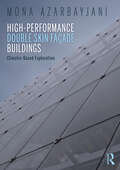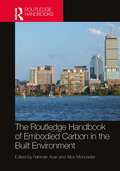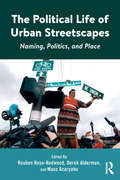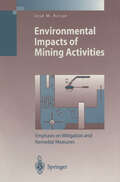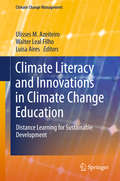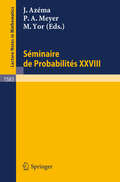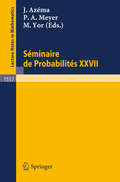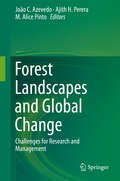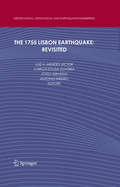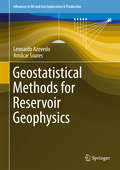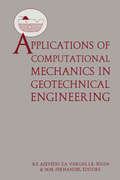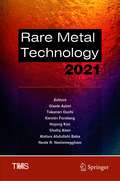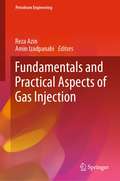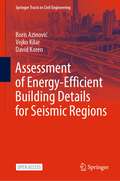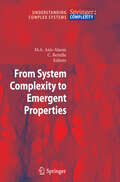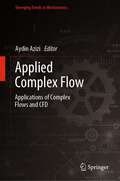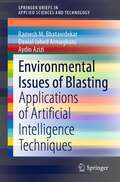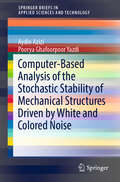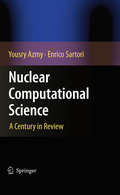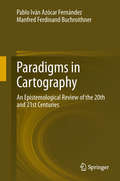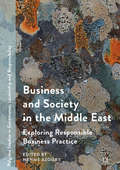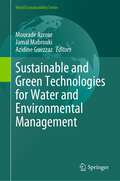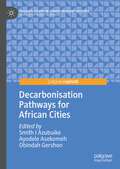- Table View
- List View
High-Performance Double Skin Façade Buildings: Climatic-Based Exploration
by Mona AzarbayjaniThis book provides a comprehensive theoretical platform for the use and construction of double skin façade projects. The DSF concept has been used mostly in European buildings; however, its success in other climates should be addressed. Increasing numbers of buildings are featuring double skin façade technology in the US; however, still relatively few have been studied for their performance in operation.This book gives architects a practical guide to analyze and evaluate the actual performance of double skin façade buildings in different climatic contexts. It is important for high-performance buildings to have tools to evaluate a design’s predicted performance to achieve specific sustainable goals. To determine that the application of DSF in different climates will provide better thermal comfort, building simulation tools analyze various thermal comfort parameters through studies of the façade and compare them with the actual building’s performance data. The book takes the reader on an on-site tour of eight DSF buildings around the US. Interviews with the buildings’ architects and engineers, owners, and users offer additional perspectives and insights into the construction and performance of these developments in building design.This will provide architects with a comprehensive understanding of the challenges and opportunities in integrating double skin façades into their projects.
The Routledge Handbook of Embodied Carbon in the Built Environment
by Rahman Azari Alice MoncasterThis handbook explores the critically important topic of embodied carbon, providing advanced insights that focus on measuring and reducing embodied carbon from across the built environment, including buildings, urban areas and cities, and construction materials and components. Split into five distinct sections, international experts, researchers, and professionals present the recent developments in the field of embodied carbon from various perspectives and at different scales of material, building, and city. Following an introduction to the embodied carbon question, the chapters in Section 1 then cover the key debates around issues such as the politics of embodied carbon, links between embodied carbon and thermal mass, and the misuse of carbon offsets. Section 2 reviews the embodied carbon policies in a selected number of countries. Sections 3, 4, and 5 approach the topic of embodied carbon from urban-, building-, and material-scale perspectives, respectively, and use case studies to demonstrate estimation techniques and present opportunities and challenges in embodied carbon mitigation. This will be important reading for upper-level students and researchers in Architecture, Urban Planning, Engineering, and Construction disciplines. Presenting case studies of embodied carbon assessment, this book will also help practicing architects, engineers, and urban planners understand embodied carbon estimation techniques and different mitigation strategies.
The Political Life of Urban Streetscapes: Naming, Politics, and Place
by Maoz Azaryahu Reuben Rose-Redwood Derek AldermanStreetscapes are part of the taken-for-granted spaces of everyday urban life, yet they are also contested arenas in which struggles over identity, memory, and place shape the social production of urban space. This book examines the role that street naming has played in the political life of urban streetscapes in both historical and contemporary cities. The renaming of streets and remaking of urban commemorative landscapes have long been key strategies that different political regimes have employed to legitimize spatial assertions of sovereign authority, ideological hegemony, and symbolic power. Over the past few decades, a rich body of critical scholarship has explored the politics of urban toponymy, and the present collection brings together the works of geographers, anthropologists, historians, linguists, planners, and political scientists to examine the power of street naming as an urban place-making practice. Covering a wide range of case studies from cities in Europe, North America, Sub-Saharan Africa, and Asia, the contributions to this volume illustrate how the naming of streets has been instrumental to the reshaping of urban spatial imaginaries and the cultural politics of place.
The Political Life of Urban Streetscapes: Naming, Politics, and Place
by Maoz Azaryahu Reuben Rose-Redwood Derek AldermanStreetscapes are part of the taken-for-granted spaces of everyday urban life, yet they are also contested arenas in which struggles over identity, memory, and place shape the social production of urban space. This book examines the role that street naming has played in the political life of urban streetscapes in both historical and contemporary cities. The renaming of streets and remaking of urban commemorative landscapes have long been key strategies that different political regimes have employed to legitimize spatial assertions of sovereign authority, ideological hegemony, and symbolic power. Over the past few decades, a rich body of critical scholarship has explored the politics of urban toponymy, and the present collection brings together the works of geographers, anthropologists, historians, linguists, planners, and political scientists to examine the power of street naming as an urban place-making practice. Covering a wide range of case studies from cities in Europe, North America, Sub-Saharan Africa, and Asia, the contributions to this volume illustrate how the naming of streets has been instrumental to the reshaping of urban spatial imaginaries and the cultural politics of place.
Environmental Impacts of Mining Activities: Emphasis on Mitigation and Remedial Measures (Environmental Science and Engineering)
by José M. AzcueSince the mining industry is still expanding, comprehensive information on the effects of mining activities on the environment is needed. This book provides information on biological and physico-chemical treatments of mining effluents, on factors affecting human health and on environmental effects that have to be taken into account by the mining industry when aiming for sustainable development of their industry. Further regulatory guidelines and legislation relevant to the decommissioning of mining sites are reviewed. Mining industry, consulting companies, and governmental agencies alike will find a wealth of valuable information in this book.
Climate Literacy and Innovations in Climate Change Education: Distance Learning for Sustainable Development (Climate Change Management)
by Ulisses M. Azeiteiro Walter Leal Filho Luísa AiresThis book addresses the links between climate change and the threats it poses to sustainable development, from a distance education perspective. Discussing current trends and challenges in sustainable development education, climate literacy and innovations in climate change education, it contributes to the global debate on the implementation of education for sustainability. It also assesses the role that e-learning can play in this process, addressing pedagogical concepts as well as the wide range of technological options now available.
Seminaire de Probabilites XXVIII (Lecture Notes in Mathematics #1583)
by Jacques Azema Paul-Andre Meyer Marc YorIn this volume of original research papers, the main topics discussed relate to the asymptotic windings of planar Brownian motion, structure equations, closure properties of stochastic integrals. The contents of the volume represent an important fraction of research undertaken by French probabilists and their collaborators from abroad during the academic year 1992-1993.
Seminaire de Probabilites XXVII (Lecture Notes in Mathematics #1557)
by Jaques Azema Paul A. Meyer Marc YorThis volume represents a part of the main result obtained by a group of French probabilists, together with the contributions of a number of colleagues, mainly from the USA and Japan. All the papers present new results obtained during the academic year 1991-1992. The main themes of the papers are: quantum probability (P.A. Meyer and S. Attal), stochastic calculus (M. Nagasawa, J.B. Walsh, F. Knight, to name a few authors), fine properties of Brownian motion (Bertoin, Burdzy, Mountford), stochastic differential geometry (Arnaudon, Elworthy), quasi-sure analysis (Lescot, Song, Hirsch). Taken all together, the papers contained in this volume reflect the main directions of the most up-to-date research in probability theory. FROM THE CONTENTS: J.P. Ansal, C. Stricker: Unicite et existence de la loi minimale.- K. Kawazu, H. Tanaka: On the maximum of a diffusion process in a drifted Brownian environment.- P.A. Meyer: Representation de martingales d'operateurs, d'apres Parthasarathy-Sinha.- K. Burdzy: Excursion laws and exceptional points on Brownian paths.- X. Fernique: Convergence en loi de variables aleatoires et de fonctions aleatoires, proprietes de compacite des lois, II.- M. Nagasawa: Principle ofsuperposition and interference of diffusion processes.- F. Knight: Some remarks on mutual windings.- S. Song: Inegalites relatives aux processus d'Ornstein-Ulhenbeck a n-parametres et capacite gaussienne c (n,2).- S. Attal, P.A. Meyer: Interpretation probabiliste et extension des integrales stochastiques non commutatives.- J. Azema, Th. Jeulin, F. Knight,M. Yor: Le theoreme d'arret en une fin d'ensemble previsible.
Forest Landscapes and Global Change: Challenges for Research and Management
by João C. Azevedo Ajith H. Perera M. Alice PintoClimate change, urban sprawl, abandonment of agriculture, intensification of forestry and agriculture, changes in energy generation and use, expansion of infrastructure networks, habitat destruction and degradation, and other drivers of change occur at increasing rates. They affect patterns and processes in forest landscapes, and modify ecosystem services derived from those ecosystems. Consequently, rapidly changing landscapes present many new challenges to scientists and managers. While it is not uncommon to encounter the terms “global change” and “landscape” together in the ecological literature, a global analyses of drivers of change in forest landscapes, and their ecological consequences have not been addressed adequately. That is the goal of this volume: an exploration of the state of knowledge of global changes in forested landscapes with emphasis on causes and effects, and challenges faced by researchers and land managers. Initial chapters identify and describe major agents of landscape change: climate, fire, and human activities. The next series of chapters address implications of changes on ecosystem services, biodiversity conservation and carbon flux. A chapter that describes methodologies of detecting and monitoring landscape changes is presented followed by chapter that highlights the many challenges forest landscape managers face amidst of global change. Finally, we present a summary and a synthesis of the main points presented in the book. Each chapter will contain the individual research experiences of chapter authors, augmented by review and synthesis of global scientific literature on relevant topics, as well as critical input from multiple peer reviewers.
The 1755 Lisbon Earthquake: Revisited (Geotechnical, Geological and Earthquake Engineering #7)
by João Azevedo A. Ribeiro Luiz Mendes-Victor Carlos Sousa OliveiraThe 1755 earthquake and tsunami were influential not only in Portugal but in all European and North African countries where the devastating effects were felt. The entire world was deeply impressed and the discussion of its causes generated a large amount of scientific and metaphysical speculation. It inspired philosophers, poets and writers. The socio-economic consequences of the event were great and affected the future organization and development of Portugal. The possibility of a similar occurence urges society and the scientific community to reflect on its lessons. AudienceThis work is of interest to experts in seismology, earthquake engineering, civil protection, urban planning and it is a reference book for doctoral students.
Geostatistical Methods for Reservoir Geophysics (Advances in Oil and Gas Exploration & Production)
by Leonardo Azevedo Amílcar SoaresThis book presents a geostatistical framework for data integration into subsurface Earth modeling. It offers extensive geostatistical background information, including detailed descriptions of the main geostatistical tools traditionally used in Earth related sciences to infer the spatial distribution of a given property of interest. This framework is then directly linked with applications in the oil and gas industry and how it can be used as the basis to simultaneously integrate geophysical data (e.g. seismic reflection data) and well-log data into reservoir modeling and characterization. All of the cutting-edge methodologies presented here are first approached from a theoretical point of view and then supplemented by sample applications from real case studies involving different geological scenarios and different challenges. The book offers a valuable resource for students who are interested in learning more about the fascinating world of geostatistics and reservoir modeling and characterization. It offers them a deeper understanding of the main geostatistical concepts and how geostatistics can be used to achieve better data integration and reservoir modeling.
Applications of Computational Mechanics in Geotechnical Engineering
by R. F. Azevedo E. A. Vargas Et Et AlThe development of constitutive relations for geotechnical materials, with the help of numerical models, have increased notably the ability to predict and to interpret mechanical behaviour of geotechnical works. These proceedings cover the applications of computational mechanics in this area.
Rare Metal Technology 2021 (The Minerals, Metals & Materials Series)
by Gisele Azimi Takanari Ouchi Kerstin Forsberg Hojong Kim Shafiq Alam Alafara Abdullahi Baba Neale R. NeelamegghamThis collection presents papers from a symposium on extraction of rare metals as well as rare extraction processing techniques used in metal production. It covers metals essential for critical modern technologies including electronics, electric motors, generators, energy storage systems, and specialty alloys. Rare metals are the main building blocks of many emerging critical technologies and have been receiving significant attention in recent years. Much research in academia and industry is devoted to finding novel techniques to extract critical and rare metals from primary and secondary sources. The technologies that rely on critical metals are dominating the world, and finding a way to extract and supply them effectively is highly desirable and beneficial. Rapid development of these technologies entails fast advancement of the resource and processing industry for their building materials. Authors from academia and industry exchange knowledge on developing, operating, and advancing extractive and processing technologies. Contributions cover rare-earth elements (magnets, catalysts, phosphors, and others), energy storage materials (lithium, cobalt, vanadium, graphite), alloy elements (scandium, niobium, titanium), and materials for electronics (gallium, germanium, indium, gold, silver). The contributions also cover various processing techniques in mineral beneficiation, hydrometallurgy, separation and purification, pyrometallurgy, electrometallurgy, supercritical fluid extraction, and recycling (batteries, magnets, electrical and electronic equipment).
Fundamentals and Practical Aspects of Gas Injection (Petroleum Engineering)
by Reza Azin Amin IzadpanahiThis book covers different aspects of gas injection, from the classic pressure maintenance operation to enhanced oil recovery (EOR), underground gas storage (UGS), and carbon capture and storage (CCS). The authors detail the unique characteristics and specific criteria of each application, including: material balance equationsphase behaviourreservoir engineeringwell designoperating aspectssurface facilitiesenvironmental issues Examples, data, and simulation codes are provided to enable the reader to gain an in-depth understanding of these applications. Fundamentals and Practical Aspects of Gas Injection will be of use to practising engineers in the fields of reservoir engineering, and enhanced oil recovery. It will also be of interest to researchers, academics, and graduate students working in the field of petroleum engineering.
Assessment of Energy-Efficient Building Details for Seismic Regions (Springer Tracts in Civil Engineering)
by Boris Azinović Vojko Kilar David KorenThis open access book presents a methodology for the assessment of structural building details, taking into account the contemporary guidelines for earthquake-resistant and energy-efficient buildings. A review of structural details for energy-efficient buildings revealed that in some cases the structural system is interrupted, leading to solutions which are not suitable for earthquake-prone regions. Such typical examples would be the use of thermal insulation under the building foundation and reduction of the load-bearing elements’ dimensions – also at the potential locations of plastic hinges which are crucial for the dissipation of seismic energy. The proposed methodology of assessment favours a collaboration of architects, engineers, contractors and investors in the early stage of building design. By this the methodology enables efficient decision-making and contributes to a selection of optimal building structural details.The book starts by presenting the typical structural details of the thermal envelope of energy-efficient buildings together with the scientific background required for understanding the process of detail development from all the relevant aspects. Over 20 examples of most frequent details are described and analysed to raise awareness of the importance of earthquake resistance, sustainability, energy-efficiency and thermal comfort for users.
Emergent Properties in Natural and Artificial Dynamical Systems (Understanding Complex Systems)
by Moulay Aziz-Alaoui Cyrille BertelleAn important part of the science of complexity is the study of emergent properties arising through dynamical processes, in various natural and artificial systems. This book presents multidisciplinary approaches for creating and modeling representations of complex systems, and a variety of methods for extracting emergent structures. Offering bio-complexity examples, the coverage extends to self organization, synchronization, stability and robustness. The contributors include researchers in physics, engineering, biology and chemistry.
From System Complexity to Emergent Properties (Understanding Complex Systems)
by Moulay Aziz-Alaoui Cyrille BertelleEmergence and complexity refer to the appearance of higher-level properties and behaviours of a system that obviously comes from the collective dynamics of that system's components. These properties are not directly deducible from the lower-level motion of that system. Emergent properties are properties of the "whole'' that are not possessed by any of the individual parts making up that whole. Such phenomena exist in various domains and can be described, using complexity concepts and thematic knowledges. This book highlights complexity modelling through dynamical or behavioral systems. The pluridisciplinary purposes, developed along the chapters, are able to design links between a wide-range of fundamental and applicative Sciences. Developing such links - instead of focusing on specific and narrow researches - is characteristic of the Science of Complexity that we try to promote by this contribution.
Applied Complex Flow: Applications of Complex Flows and CFD (Emerging Trends in Mechatronics)
by Aydin AziziThis book presents improved numerical techniques and applied computer-aided simulations as a part of emerging trends in mechatronics in all areas related to complex fluids, with particular focus on using a combination of modeling, theory, and simulation to study systems that are complex due to the rheology of fluids (i.e., ceramic pastes, polymer solutions and melts, colloidal suspensions, emulsions, foams, micro-/nanofluids, etc.) and multiphysics phenomena in which the interactions of various effects (thermal, chemical, electric, magnetic, or mechanical) lead to complex dynamics. The areas of applications span materials processing, manufacturing, and biology.
Environmental Issues of Blasting: Applications of Artificial Intelligence Techniques (SpringerBriefs in Applied Sciences and Technology)
by Aydin Azizi Danial Jahed Armaghani Ramesh M. BhatawdekarThis book gives a rigorous and up-to-date study of the various AI and machine learning algorithms for resolving environmental challenges associated with blasting. Blasting is a critical activity in any mining or civil engineering project for breaking down hard rock masses. A small amount of explosive energy is only used during blasting to fracture rock in order to achieve the appropriate fragmentation, throw, and development of muck pile. The surplus energy is transformed into unfavourable environmental effects such as back-break, flyrock, air overpressure, and ground vibration. The advancement of artificial intelligence and machine learning techniques has increased the accuracy of predicting these environmental impacts of blasting. This book discusses the effective application of these strategies in forecasting, mitigating, and regulating the aforementioned blasting environmental hazards.
Computer-Based Analysis of the Stochastic Stability of Mechanical Structures Driven by White and Colored Noise (SpringerBriefs in Applied Sciences and Technology)
by Aydin Azizi Poorya Ghafoorpoor YazdiThis book provides a concise introduction to the behavior of mechanical structures and testing their stochastic stability under the influence of noise. It explains the physical effects of noise and in particular the concept of Gaussian white noise. In closing, the book explains how to model the effects of noise on mechanical structures, and how to nullify / compensate for it by designing effective controllers.
Nuclear Computational Science: A Century in Review
by Yousry Azmy Enrico SartoriNuclear engineering has undergone extensive progress over the years. In the past century, colossal developments have been made and with specific reference to the mathematical theory and computational science underlying this discipline, advances in areas such as high-order discretization methods, Krylov Methods and Iteration Acceleration have steadily grown. Nuclear Computational Science: A Century in Review addresses these topics and many more; topics which hold special ties to the first half of the century, and topics focused around the unique combination of nuclear engineering, computational science and mathematical theory. Comprising eight chapters, Nuclear Computational Science: A Century in Review incorporates a number of carefully selected issues representing a variety of problems, providing the reader with a wealth of information in both a clear and concise manner. The comprehensive nature of the coverage and the stature of the contributing authors combine to make this a unique landmark publication. Targeting the medium to advanced level academic, this book will appeal to researchers and students with an interest in the progression of mathematical theory and its application to nuclear computational science.
Paradigms in Cartography: An Epistemological Review of the 20th and 21st Centuries
by Pablo Iván Azócar Fernández Manfred Ferdinand BuchroithnerIn this book the main trends, concepts and directions in cartography and mapping in modernism and post-modernism are reviewed. Philosophical and epistemological issues are analysed in cartography from positivist-empiricist, neo-positivist and post-structuralist stances. In general, in cartography technological aspects have been considered as well as theoretical issues. The aim is to highlight the epistemological and philosophical viewpoint during the development of the discipline. Some main philosophers who have been influential for contemporary thinking such as Immanuel Kant, Ludwig Wittgenstein, Karl Popper and Bertrand Russell, are considered. None of these philosophers wrote about cartography directly (excepting Kant), but their philosophies are related to cartography and mapping issues. The book also analyses the concept of paradigm or paradigm shift coined by Thomas Kuhn, who applied it to the history of science. Different cartographic trends that have arisen since the second half of the twentieth century are analysed according to this important concept which is implicit inside the scientific or disciplinary communities. Further, the authors analyse the position of cartography in the context of the sciences and other disciplines, adopting a positivistic point of view. Additionally, they review current trends in cartography and mapping in the context of information and communication technologies in a post-modernistic or post-structuralistic framework. Thus, since the 1980s and 1990s, new mapping concepts have arisen which challenge the discipline’s traditional map conceptions.
Business and Society in the Middle East: Exploring Responsible Business Practice (Palgrave Studies in Governance, Leadership and Responsibility)
by Nehme AzouryThis book discusses the unique relationship between societies and businesses in the Mediterranean region, with contributions from public figures and academics from Middle Eastern and Arab societies, as well as from North America and Europe. This blend of expertise and knowledge focuses on common business practices and their effect on society in Mediterranean countries, and aims to create a bridge between the two. Considering the cultural, social, political, legal and economic impacts and variety, Business and Society in the Middle East is a contemporary and authentic view of how local and traditional aspects of society dictate diversity and homogeneity within businesses.
Sustainable and Green Technologies for Water and Environmental Management (World Sustainability Series)
by Mourade Azrour Jamal Mabrouki Azidine GuezzazThis book introduces a variety of the latest researches that are related to smart devices, machine learning algorithms, and the Internet of things that are applied for a sustainable environment. These recent technologies cover all fields including agriculture, transportation, smart grid, smart building, and others. In addition, IoT has provided an innovative vision that is completely alternative to the conventional methodologies: the new approach comes in the form of a single-component system that can be connected to the network and can incorporate smart policies. As a consequence, the covered subjects encompass smart system design and control, networking and machine learning, environmental monitoring and surveillance, smart meters, authentication and authorization, ensuring private data security, software solutions, and systems, among others. This book covers subjects that are related to the Internet of Things and smart used tools and methods for fighting environmental problems. Therefore, it discusses recent ideas that are not covered by other competitor books. This book is different because it can be a reference for researchers, professionals, and students in both smart thinking and environmental domains.
Decarbonisation Pathways for African Cities (Palgrave Studies in Climate Resilient Societies)
by Smith I Azubuike Ayodele Asekomeh Obindah GershonThis book examines the pathways to decarbonising African cities, structured around strategies and applications in renewable energy, waste management, healthcare, telecommunication, education and governance reconfigurations for Petro-cities. Throughout the book the authors highlight infrastructural, governance and policy approaches to drive decarbonisation. Opening with chapters focused on propositions for solar urban planning and scope for decarbonisation in waste management the book then moves on to examine innovative strategies for a low-carbon healthcare sector. The authors then discuss the use of hybrid power systems at remote telecommunication sites, their deployment on university campuses, and how this can be optimised to reduce carbon emissions. Further chapters explore government, private sector and civil society actions for decarbonising Kenyan cities and an overview of the political economic choices for decarbonising Petro-cities. Finally, closing chapters propose mechanisms for translating COP26 takeaways to decarbonisation policies and a low-carbon framework for African cities.
